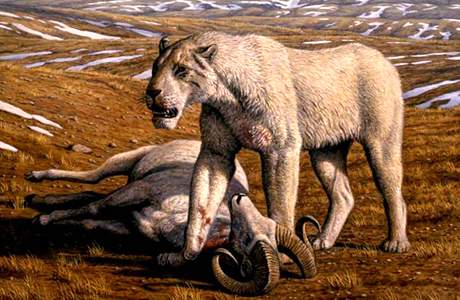Apart from lions, and the surviving lynxes, bobcats, and cougars, Canada once had two other felid species. These were the scimitar cat (Homotherium serum) and the American cheetah (Miracinonyx trumani). The scimitar cat was a large, big-game predator found in the northern reaches of Canada and Alaska, and was a distant relative of the sabre-toothed cats (Smilodon). The American cheetah was a close relative of mountain lions and modern cheetahs, found on the great plains.
The scimitar cat most likely went extinct as a result of large prey species going extinct, similar to the American lion. It would have been a major predator of large herbivores, such as mammoths, mastodons, and possibly ground sloths. It was roughly the size of a lion or tiger, but was built more like a hyena, with slightly longer front legs than back legs. It also had long, serrating teeth meant for slashing the necks of large, thick-skinned prey. It's cranial, nasal, and legs anatomy suggest that it was a sprinting predator, adapted for quick ambushes at high speeds.
Unfortunately a perfect proxy for Homotherium doesn't really exist. All of the sabre-toothed cats are extinct and modern felines are only distantly related. The truth is that a proxy for them would not really be necessary until elephants were present again. At that time, it is conceivable that lions would, like the scimitar cat, be able to control elephant populations by preying on calves. If a specific proxy were desired, perhaps Amur leopards (Panthera pardus orientalis) or Siberian tigers (Panthera tigris altaica) would be suitable. It's fair to say that Homotherium probably preyed on smaller prey as well, and having a large, cold-adapted predator would help in controlling numbers of deer and pigs. The tiger is closer in size to the scimitar cat, but the leopard is probably closer in habits and speed. If either of these cats were used, there would be concern for how they interact with other native predators. Siberian tigers are already sympatric with leopards, bears and wolves and might control numbers of either through competition and even predation. Tigers and leopards both are or have been found in the same areas as lions and lynxes. Lions have been found in the same places as cougars (Puma concolor cougar) in the past, though it is not sure how they interacted or whether having them in the same places as other large cast would cause problems
The American cheetah, though similar in build to the cheetah, was more closely related to the cougar. Due to it's slightly larger size, it was probably not quite as fast as the modern cheetah (Acinonyx jubatus) but would have been the fastest predator present in Pleistocene North America. It is thought that the pronghorn (Antilocapra americana), which is much faster than any living North American predator, became the second-fastest land animal in the world in evolutionary response to predation by the American cheetah.
Any of the cheetah subspecies could be used to control pronghorn and deer populations in the North American plains. The critically endangered Asiatic cheetah (Acinonyx jubatus venaticus) might be the variety best suited to inhabit the Canadian plains. This subspecies is suited to much colder, steppe-like conditions than it's cousins. However, there are as few as forty of them left in Iran, and so it may be much more practical to use any of the African subspecies. However if the situation was deemed extreme enough it might even be logical to take as many as twenty of the Asiatic cheetahs as a backup population so that they might be protected from the poaching, habitat loss, and traffic accidents that have endangered them. A breeding population could grow fast and be used as both a founding population for North America and a recovering population for the Middle-East and India. Genetic diversity would be low but genetic diversity has always been low in cheetahs as far as can be told.
Top to bottom:
Homotherium depiction - https://retrieverman.files.wordpress.com/2010/04/homotherium.jpg
Miracinonyx depiction - https://blueline2011.files.wordpress.com/2011/11/american-cheetah.jpg
Siberian Tiger - https://upload.wikimedia.org/wikipedia/commons/b/b9/P.t.altaica_Tomak_Male.jpg
Amur Leopard - http://i1.wp.com/visitcryptoville.com/wp-content/uploads/2015/02/amur-leopard-in-snow.jpg
Asiatic Cheetah - https://upload.wikimedia.org/wikipedia/commons/7/72/Kushki_%26_rubit.jpg




No comments:
Post a Comment